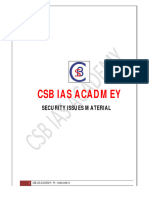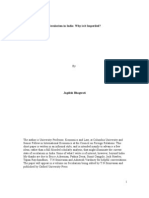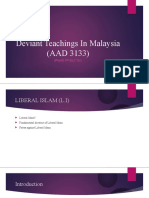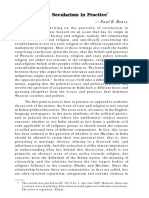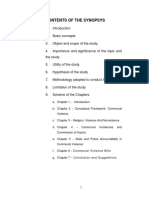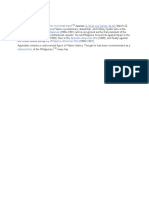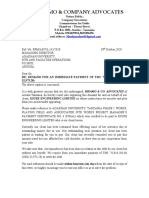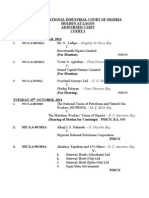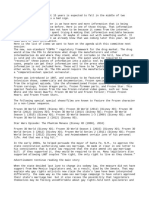TCWD 111 Group 5
TCWD 111 Group 5
Uploaded by
DAVE BARIBECopyright:
Available Formats
TCWD 111 Group 5
TCWD 111 Group 5
Uploaded by
DAVE BARIBEOriginal Title
Copyright
Available Formats
Share this document
Did you find this document useful?
Is this content inappropriate?
Copyright:
Available Formats
TCWD 111 Group 5
TCWD 111 Group 5
Uploaded by
DAVE BARIBECopyright:
Available Formats
TCWD 111
PREPARED BY GROUP 5
MEMBERS:
● Baribe, Dave
● Dionero , Paolo Angelo
● Java, Shame
● Pineda, Rashanti Nicole
● Remulta, Ria
● Usman, Shealame
Ethnic cleansing in India
Background Information
This paper attempts to explain the complicated relationship between Hindus and Muslims
as well as analyze its roots, which date back to before British control. Through this historical
lens, one can find the prerequisite for conflict and for peace. Then, the analysis shifts to current
events where some of the previous themes manifest themselves in societal violence. Upon
completing an analysis of the roots, drivers, and actors within this conflict, the paper then
suggests potential paths to de-escalate and prevent further violence.
The conflict between Hindus and Muslims:
● After WWII-Britain gives India independence
● transition chaotic with Muslims and Hindus turning against each other
● 1947 India is partitioned:
- India- Hindu
- leader = Gandhi
- Leader = Jawaharlal Nehru (Indian national congress) - wanted a more modern
industrial India
● Pakistan - Muslim
- leader = Muhammad Ali Jinnah (Muslim league)
- Kashmir (western part of sub-continent) - Muslim cause of future conflict
● Conflict takes the lives of over 500,000 including Gandhi ( killed in 1948 by a Hindu
refugee
● ANTI-MUSLIM
● The two groups were fighting for control over the province of Kasmir
● They clashed due to vast differences in religions and cultures
● To know who is a superior ethnoreligious group.
● Border dispute, Kashmir problem, Water dispute, and terror controversy.
● it was only about land, gold, or politics.
TThe purpose of this research is to
investigate the origins of civil and human rights violations that are occurring in India’s Assam
district and have the potential to metastasize throughout all of India. This conflict involves two
main religions that diverse ethnic groups in India follow. The majority religion that Indians
follow is Hinduism, and the second largest is Islam. What makes this conflict ethnoreligious is
that neither Hinduism nor Islam pertains to one ethnic group; rather, they represent ideas that can
be adopted by any human being who finds them attractive.
1. When did this event happen? Or if it is still happening, when did it start?
- In 1947, Hindu nationalists violently attacked Muslims, forming communal violence
between Hindus and Muslims. and yes until now it's happens
2. What ethnic group is/was targeted?
- Islam or the Muslims, are the ones who experienced hardship and oppressive measures.
The Muslim greater population can face immense persecution as they become more
clearly defined as “enemies of the State.” Fear of insurrection, sabotage, terrorism, and
other actions could offer an incentive to remove Muslims from office and further attack
their communities or detain Muslims in general.
3. Who is/was the bigger power behind this supposed 'ethnic cleansing'?
Based on the comparison brief India is ranked 4
out of 145 while Pakistan is ranked 7 out of 145
so the bigger power behind this ethnic cleansing
in India
4. How was the act of ethnic cleansing carried
out by this bigger power? Like, what strategies are/were used?
- The bigger power which is the Hindus carried out ethnic cleansing by heavily relying on
legal means to depart or cleanse an area of Muslims. Since India is a democratic country,
it tends to avoid mass murder or ethnic cleansing however, majoritarian tyranny is just as
destructive. The Hindus become more aggressive and forceful as they attempted to
pursue a legal path of deporting 1.9 million Muslims in the Assam District by making
illegal immigration a core issue to win nationalist sentiment and start a rally.
- Another strategy is using the National Register of Citizens and Citizens Amendment Act
making the Muslims primarily bear the punitive consequences of exclusion from NRC
with include statelessness, deportation, or prolonged detention that caused widespread
protest and civil unrest.
5. What is your group's general opinion about this situation?
- Many people get harmed and involved in violence and killings that spread in India.
Muslim and Hindus have co-existed in one country living their own life before the
conflict. Muslims considered India as their land and home. Muslims are not invaders their
purpose is to have a better life and improvements. They have different religions but they
can live in one country peacefully if they resolve it calmly without violence. An example
of living peacefully is the Philippines. There are so many Muslims here but we don't have
a problem with them, even though we have different beliefs, it is because we respect each
other religion and we just live our lives.
You might also like
- A Brief History of the Present Muslims in New India (Hilal Ahmed)Document244 pagesA Brief History of the Present Muslims in New India (Hilal Ahmed)YuanHongNo ratings yet
- The Roots of Nationalism in The Muslim WorldDocument25 pagesThe Roots of Nationalism in The Muslim WorldSalim UllahNo ratings yet
- Gandhi Movie SummaryDocument2 pagesGandhi Movie Summaryvidur_talreja50% (4)
- IICR Research Paper IslamophobiaDocument19 pagesIICR Research Paper IslamophobiaMARIA TARIQNo ratings yet
- Challenges Before The HindusDocument65 pagesChallenges Before The HindusParikshit SachdevNo ratings yet
- Justice For AllDocument8 pagesJustice For Allmdsaif28887No ratings yet
- Imj - 2010 - Cftra - Global PDFDocument58 pagesImj - 2010 - Cftra - Global PDFConfidence FoundationNo ratings yet
- Phase-1 Development and Contribution of Ideology Before 1947.Document11 pagesPhase-1 Development and Contribution of Ideology Before 1947.MIAN WasiFNo ratings yet
- Socio Economic Problems of IndiaDocument30 pagesSocio Economic Problems of IndiaDhiraj Yuvraj83% (6)
- 'Problem of CommunalismDocument8 pages'Problem of CommunalismShaikh RazzakNo ratings yet
- De-Hinduising The Indian NationDocument20 pagesDe-Hinduising The Indian Nationkingponting100% (1)
- CONSTITUTIONAL RIGHTS OF MINORITIES - by Saika Sabir PDFDocument22 pagesCONSTITUTIONAL RIGHTS OF MINORITIES - by Saika Sabir PDFSaiby KhanNo ratings yet
- Content://co - Thanos.vrdlc - Thanos.provider/root folder/Download/Classplus/Free%20Study%20Material%20/SECURITY%20ISSUES%20NOTES%20-%201%20 (2)Document55 pagesContent://co - Thanos.vrdlc - Thanos.provider/root folder/Download/Classplus/Free%20Study%20Material%20/SECURITY%20ISSUES%20NOTES%20-%201%20 (2)Pasupuleti SubrahmanyamNo ratings yet
- Letter of SubogationDocument8 pagesLetter of SubogationSanjay SinghNo ratings yet
- Religious Communalism in India - Critical AnalysisDocument17 pagesReligious Communalism in India - Critical AnalysisYubraj SwainNo ratings yet
- Communal HarmonyDocument27 pagesCommunal HarmonyBhushan KadNo ratings yet
- Secularism in IndiaDocument13 pagesSecularism in IndiaschoudhuryNo ratings yet
- Introduction:-The Cow Protection Movement Has Been A Religious and Political MovementDocument13 pagesIntroduction:-The Cow Protection Movement Has Been A Religious and Political MovementmohdportmanNo ratings yet
- Communal ViolenceDocument24 pagesCommunal ViolenceRamdev RajpurohitNo ratings yet
- Prabuddha: JOurnal of Social Equality Vol.1Document105 pagesPrabuddha: JOurnal of Social Equality Vol.1sreenathpnrNo ratings yet
- Causes of The Partition of IndiaDocument18 pagesCauses of The Partition of IndiaCHHOTE LAL SHAWNo ratings yet
- Nda Review Meet: Hindu Policy Summit 2016Document16 pagesNda Review Meet: Hindu Policy Summit 2016hh rickyNo ratings yet
- Liberal IslamDocument20 pagesLiberal IslamMOHD NURZET HAYAT BIN MOHD MAZLAN KPM-GuruNo ratings yet
- JESWIN Communalism and Fundamentalism - Religous MovementsDocument5 pagesJESWIN Communalism and Fundamentalism - Religous MovementsverutheundakiyathuNo ratings yet
- Emerging Majoritarian Threat To Indian Pluralism: A Challenge and ResponseDocument13 pagesEmerging Majoritarian Threat To Indian Pluralism: A Challenge and ResponseMohammed KhalidNo ratings yet
- Growth of Human Rights Law in IndiaDocument20 pagesGrowth of Human Rights Law in IndiaParth Tiwari100% (1)
- Evolution of Two Nation TheoryDocument7 pagesEvolution of Two Nation TheoryMIAN WasiF100% (1)
- Indian Secularism in PracticeDocument18 pagesIndian Secularism in PracticeAnonymous 4yXWpDNo ratings yet
- Q. "Regionalism Is A Threat To Maintaining Unity in Diversity' in India." Critically Analyse The Given Statement. (250 Words)Document185 pagesQ. "Regionalism Is A Threat To Maintaining Unity in Diversity' in India." Critically Analyse The Given Statement. (250 Words)KarsanNo ratings yet
- Essay About The Human Rights ViolationsDocument3 pagesEssay About The Human Rights ViolationsJoão CoelhoNo ratings yet
- Sir Syed Ahmed Khan, Allama Iqbal, Quaid-e-AzamDocument13 pagesSir Syed Ahmed Khan, Allama Iqbal, Quaid-e-Azamayesha ambreenNo ratings yet
- Sample 2Document2 pagesSample 2Sumedha VatsNo ratings yet
- SynopsisDocument24 pagesSynopsisGovind chaurasiaNo ratings yet
- 273-Article Text-652-2-10-20210308Document12 pages273-Article Text-652-2-10-20210308Fajar ImanNo ratings yet
- A Perspective On The Prospects of Inter Religious DialogueDocument10 pagesA Perspective On The Prospects of Inter Religious DialogueLama AjoyNo ratings yet
- UNHRC Study GuideDocument7 pagesUNHRC Study GuideAli AzlanNo ratings yet
- Splitting India FullDocument36 pagesSplitting India Fullsingh1910511753No ratings yet
- Final Thesis DoneDocument29 pagesFinal Thesis Doneapi-253464696No ratings yet
- Casteism in India: Contemporary Reading From Islamic PerspectiveDocument47 pagesCasteism in India: Contemporary Reading From Islamic Perspectivehafsa abdurahmanNo ratings yet
- Kritvi - TOK Exhibition CommentaryDocument6 pagesKritvi - TOK Exhibition CommentaryKritviiiNo ratings yet
- Hindus in South Asia & The Diaspora: A Survey of Human Rights, 2013Document303 pagesHindus in South Asia & The Diaspora: A Survey of Human Rights, 2013Hindu American FoundationNo ratings yet
- Chapter 1-2Document13 pagesChapter 1-2morzilNo ratings yet
- Terrorism in Three Religious Tradition-INTERCULTDocument8 pagesTerrorism in Three Religious Tradition-INTERCULTAhmaNo ratings yet
- Conversion Mafia FinalDocument52 pagesConversion Mafia FinalSayan BiswasNo ratings yet
- Roots of Nationalism in The Muslim World: Shabir AhmedDocument25 pagesRoots of Nationalism in The Muslim World: Shabir AhmedAlvy AsyaukaniNo ratings yet
- Islamophobia-Resource 0Document8 pagesIslamophobia-Resource 0fmanyan12No ratings yet
- Problems Faced by Muslim Minorities in India and Role of Mass MediaDocument12 pagesProblems Faced by Muslim Minorities in India and Role of Mass Mediabulbulswain929No ratings yet
- Pakstudy LacturesDocument40 pagesPakstudy LactureslaibaNo ratings yet
- Politics of Communi IsmDocument28 pagesPolitics of Communi IsmRamdev RajpurohitNo ratings yet
- Chapter 1 Introduction Religion and PoliDocument57 pagesChapter 1 Introduction Religion and PoliRoyal MajesticNo ratings yet
- Communalism FinalDocument16 pagesCommunalism FinalOmkar RautNo ratings yet
- Letter To Irf-Rt: Reject Islamic Propaganda Against IndiaDocument7 pagesLetter To Irf-Rt: Reject Islamic Propaganda Against IndiaPGurus100% (1)
- Populism Converts Into Fascism: Resarch Analysis of Hindutva and Its Implications On Minorities.Document34 pagesPopulism Converts Into Fascism: Resarch Analysis of Hindutva and Its Implications On Minorities.Muhammad QasimNo ratings yet
- Evolution of Two Nation Theory...Document15 pagesEvolution of Two Nation Theory...Aliya RabaniNo ratings yet
- Pak Study Lecture 1 To 18Document85 pagesPak Study Lecture 1 To 18GOKU BLACKNo ratings yet
- Religious Conversion in India: The Niyogi Committee Report of Madhya Pradesh in 1956 and Its Continuing Impact on National UnityFrom EverandReligious Conversion in India: The Niyogi Committee Report of Madhya Pradesh in 1956 and Its Continuing Impact on National UnityNo ratings yet
- (Ram Puniyani) Religion, Power and ViolenceDocument333 pages(Ram Puniyani) Religion, Power and Violencechitwanjit100% (1)
- Ilovepdf MergedDocument45 pagesIlovepdf Mergedmohammadshawail518No ratings yet
- The Common Sense Muslim: Treatise on Islamic Justice, Muslim Unity, and Islam in the WestFrom EverandThe Common Sense Muslim: Treatise on Islamic Justice, Muslim Unity, and Islam in the WestNo ratings yet
- Week 1 - NCMA 219 LecDocument12 pagesWeek 1 - NCMA 219 LecDAVE BARIBENo ratings yet
- Group 1 Climate ChangeDocument4 pagesGroup 1 Climate ChangeDAVE BARIBENo ratings yet
- Week 1 - NCMA 219 LecDocument27 pagesWeek 1 - NCMA 219 LecDAVE BARIBENo ratings yet
- Genetic Assessment and CounsellingDocument15 pagesGenetic Assessment and CounsellingDAVE BARIBENo ratings yet
- Ncam219 Lec PDFDocument102 pagesNcam219 Lec PDFDAVE BARIBENo ratings yet
- Week 10 - Anemias of Pregnancy PDFDocument24 pagesWeek 10 - Anemias of Pregnancy PDFDAVE BARIBENo ratings yet
- Untitled DocumentDocument7 pagesUntitled DocumentDAVE BARIBENo ratings yet
- Andrés Bonifacio: Bonifacio Spanish Name SurnameDocument3 pagesAndrés Bonifacio: Bonifacio Spanish Name SurnameDAVE BARIBENo ratings yet
- République Française (: French RepublicDocument6 pagesRépublique Française (: French RepublicDAVE BARIBENo ratings yet
- Emilio Aguinaldo y FamyDocument1 pageEmilio Aguinaldo y FamyDAVE BARIBENo ratings yet
- Early Life: Kevin Michael "GG" Allin (Born Jesus Christ Allin August 29, 1956 - June 28, 1993) Was AnDocument1 pageEarly Life: Kevin Michael "GG" Allin (Born Jesus Christ Allin August 29, 1956 - June 28, 1993) Was AnDAVE BARIBENo ratings yet
- Political Caricature Questions g4Document1 pagePolitical Caricature Questions g4DAVE BARIBENo ratings yet
- Week 8 - CRITICAL WRITING IN THE ACADEME PDFDocument5 pagesWeek 8 - CRITICAL WRITING IN THE ACADEME PDFDAVE BARIBENo ratings yet
- Public International LawDocument77 pagesPublic International LawILI PHHC100% (1)
- Industrial Relations: Unit 7Document24 pagesIndustrial Relations: Unit 7Rahul Pinnamaneni100% (10)
- Accounting Research MethodDocument3 pagesAccounting Research MethodMarie GarpiaNo ratings yet
- 11.16 Police Radio and Cad Communications - RedactedDocument6 pages11.16 Police Radio and Cad Communications - RedactedOpenOversightVA.orgNo ratings yet
- Father Saturnino Urios University College Guidance Center Butuan City Student Individual Inventory FormDocument4 pagesFather Saturnino Urios University College Guidance Center Butuan City Student Individual Inventory FormTHERESE YZABEL CLOMANo ratings yet
- Demand Letter Kiure LimitedDocument2 pagesDemand Letter Kiure LimitedMambo Joshua100% (1)
- Oil and Natural Gas Corporation Limited: Office of Incharge HR-ERDocument5 pagesOil and Natural Gas Corporation Limited: Office of Incharge HR-ERpratishtha vermaNo ratings yet
- CIV GATMAYTAN vs. MLI (2020)Document20 pagesCIV GATMAYTAN vs. MLI (2020)Elle Alorra Rubenfield100% (1)
- An Inspector Calls - Themes & Quotes (Condensed)Document21 pagesAn Inspector Calls - Themes & Quotes (Condensed)boaduapauNo ratings yet
- Albrehi CV March20Document3 pagesAlbrehi CV March20api-270005305No ratings yet
- Bunag JR VS CaDocument5 pagesBunag JR VS CaAndree MorañaNo ratings yet
- Taxation of Charitable Trusts - CA Vijay Joshi-8.12.2017Document108 pagesTaxation of Charitable Trusts - CA Vijay Joshi-8.12.2017sakshi singhNo ratings yet
- Innocuousism Elective ShiereyDocument3 pagesInnocuousism Elective ShiereyMaria CeciliaNo ratings yet
- Department of Education Locator Slip: Republic of The PhilippinesDocument2 pagesDepartment of Education Locator Slip: Republic of The PhilippinesMylene N. MacedaNo ratings yet
- Change of StatusDocument2 pagesChange of StatusJessica OcheaNo ratings yet
- World War II - EditedDocument3 pagesWorld War II - EditedmelkyNo ratings yet
- Penalty Presentation 270ADocument17 pagesPenalty Presentation 270ASrushti BhattNo ratings yet
- NICN Cause List Oct./Nov.Document8 pagesNICN Cause List Oct./Nov.nicnigeria30No ratings yet
- Labor Relations Process 11th Edition Holley Solutions Manual 1Document13 pagesLabor Relations Process 11th Edition Holley Solutions Manual 1frances100% (66)
- Partnership Contract in Participation For The Construction of PropertyDocument5 pagesPartnership Contract in Participation For The Construction of PropertyScribdTranslationsNo ratings yet
- IBP E-Ballot 2023 010Document1 pageIBP E-Ballot 2023 010Gail FernandezNo ratings yet
- Cambridge International AS & A Level: HISTORY 9489/32Document4 pagesCambridge International AS & A Level: HISTORY 9489/32Eshaal Hamza MalikNo ratings yet
- Nexdigm, Formerly Known As SKP Business Consulting, Strengthens US Presence and Capabilities With The Addition of A Senior Executive DirectorDocument2 pagesNexdigm, Formerly Known As SKP Business Consulting, Strengthens US Presence and Capabilities With The Addition of A Senior Executive DirectorPR.comNo ratings yet
- Review of The Environmental Policy Instruments in The Standardization of H For The Decarbonization of MexicoDocument9 pagesReview of The Environmental Policy Instruments in The Standardization of H For The Decarbonization of MexicoMARTIN PINEDA TAVERANo ratings yet
- Co-Ownership - Pardell Vs BartolomeDocument6 pagesCo-Ownership - Pardell Vs BartolomeLloyd David P. VicedoNo ratings yet
- Obe Dues Challan Tamplate - Report Student Challan From Template ViewDocument1 pageObe Dues Challan Tamplate - Report Student Challan From Template ViewMajoNo ratings yet
- CSC248 Presentation 8Document4 pagesCSC248 Presentation 8Josh OscarNo ratings yet
- Bloom Into You Vol - 6 6 - Nakatani Nio - Bloom Into You, 6, 2017Document179 pagesBloom Into You Vol - 6 6 - Nakatani Nio - Bloom Into You, 6, 2017Milena SbNo ratings yet
- Affirmative Action - Abdullah Nasir SirDocument5 pagesAffirmative Action - Abdullah Nasir SirMohd YousufNo ratings yet













